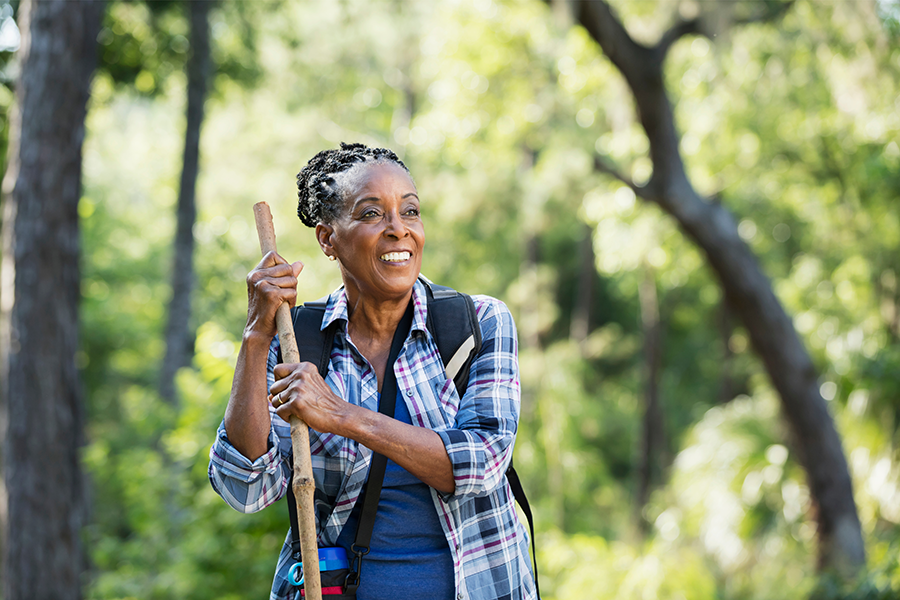Stay safe and active this summer with this helpful guide.

If you’re looking for a hobby that combines exercise, the outdoors, and scenic views, hiking is a great activity. Hiking offers the benefit of physical exercise and the rejuvenation of being in nature. It’s important to consider your hikes before you leave and ensure you follow safety guidelines, as well as consulting your healthcare provider if hiking is a new activity for you. Here are some tips for safe hiking to consider for your next outdoor adventure!
Research Trails and Check Weather Conditions
Before setting out on your hike, it’s important to choose a trail that matches your fitness level and hiking experience. Use reputable websites, park maps, and apps to read reviews and check the difficulty ratings of trails. Understanding the terrain, distance, elevation gain, and estimated completion time can help you adequately prepare and avoid unpleasant surprises.
Also important is checking the general weather conditions for the area and taking a look on the day of your hike. Weather in the mountains and forests can change rapidly, and being caught unprepared in a rainstorm or heatwave can be dangerous. Check the forecast regularly in the days leading up to your hike and again several hours before you depart.
Pack the Essentials
What you bring on a hike can make the difference between a successful outing and a potentially dangerous situation. Hydration is key to a safe hike, so bring more water than you think you’ll need. Having constant access to water is important for your body and for a safe hiking experience. Pack high-energy, non-perishable snacks for a quick energy boost for your hikes as well. Granola bars, nuts, dried fruits, and protein bars are all great options.
Always bring a map and a compass. GPS devices and smartphone apps are useful, but they can fail or run out of battery, so having a physical map as a backup is wise. You can also take a picture of the trail map ahead of time if you’re going on a simple route. Dress in layers to easily adapt to changing weather conditions or your comfort level during your hike. If you are in a more wooded area, along with wearing appropriate attire, be sure to bring bug spray along to keep from getting bitten. And, make sure to take and use sunscreen (especially on your ears!) during your hike to help prevent sun damage.
Tell Someone Your Plans
Always inform someone—a family member, friend, or park ranger—of your hiking plans. Include details such as your intended trail, start and end times, and who you’re going with. This ensures that people know your location and plans if something unexpected were to occur during your hike. While most hikes are simple, easy adventures, it’s smart to inform someone behind the scenes just in case the unexpected happens.
Stay on Marked Trails
Staying on the designated trails protects you from getting lost and minimizes your impact on the environment. Trail designers have carefully planned routes to sustain heavy foot traffic and avoid causing erosion or other environmental harm. Venturing off the path can damage fragile ecosystems and increase your risk of encountering dangerous terrain or wildlife. Staying on trails is the easiest way to ensure you’re on the right path and limits your risk of getting lost, too.
Handle Wildlife Encounters Wisely
Understanding how to handle possible wildlife encounters is important for your safety and the animals’ safety. Research the types of wildlife you might encounter in the area and read up on how to behave if you meet them. Maintain a healthy and respectful distance if you do come across wildlife.
Know Your Limits
It’s important to be realistic about your physical abilities. Pushing yourself too hard can spoil your enjoyment and increase the risk of injuries. Take regular breaks, especially on longer and more strenuous hikes, to rest and hydrate. It’s a good time to stop and enjoy the scenery as well.
Be Prepared for Emergencies
Even with the best preparation, emergencies can still happen. Familiarize yourself with basic first aid, and learn the symptoms of heat exhaustion, dehydration, and hypothermia. Carry first aid or safety items in your pack, have a fully charged cell phone, and make sure to hike with a friend or companion on your adventures.
By following these tips for safe hiking, you’ll be well-prepared to enjoy the trails safely. For more healthy lifestyle tips, take a look at the CapTel blog.


